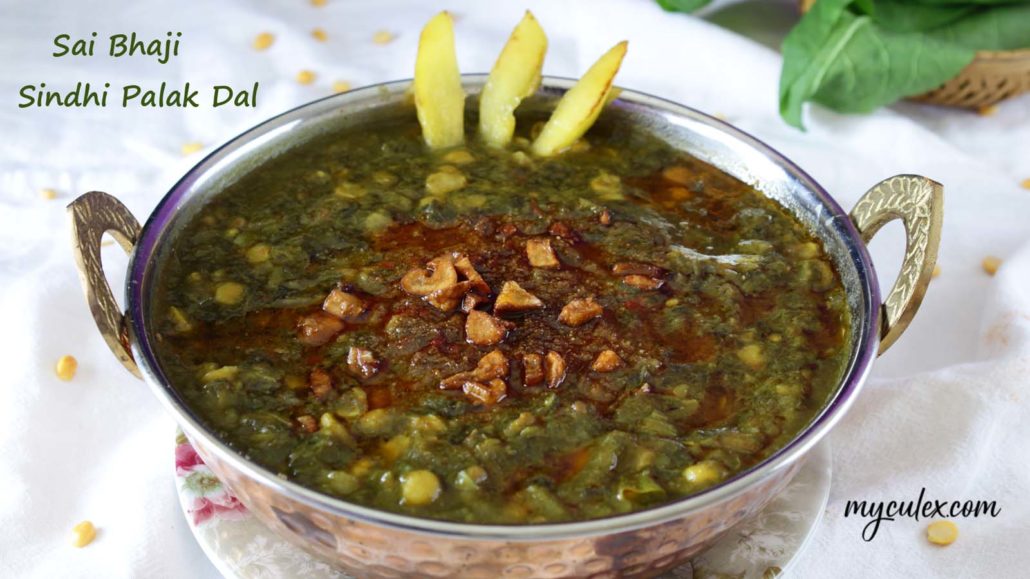
Sindhi Sai Bhaji | Spinach Lentil Vegetable
Jump to Recipe Jump to Video
Sindhi Sai Bhaji | Spinach Lentil Vegetable | Sindhi Style Dal Palak | Easy Saibhaji Recipe | How to make Sai Bhaji in Pressure Cooker
Sindhi Sai Bhaji | Spinach Lentil Vegetable | Sindhi Style Dal Palak | Easy Saibhaji Recipe | How to make Sai Bhaji in Pressure Cooker with step by step instructions
Sai Bhaji in pressure cooker saves time and fuel. It minimizes loss of nutrients as well as ensures that the greens are mashed while the chana dal retains its shape.
This Sindhi Style Dal Palak is a nutritious blend of lentils and leafy vegetables. Typically it is made with spinach, Chana dal, sorrel (chukka), dill (sua), fenugreek leaves, colocasia (arvi), eggplant, tomatoes, onions, ginger, basic dry spice powders, and tempering with garlic or cumin seeds.
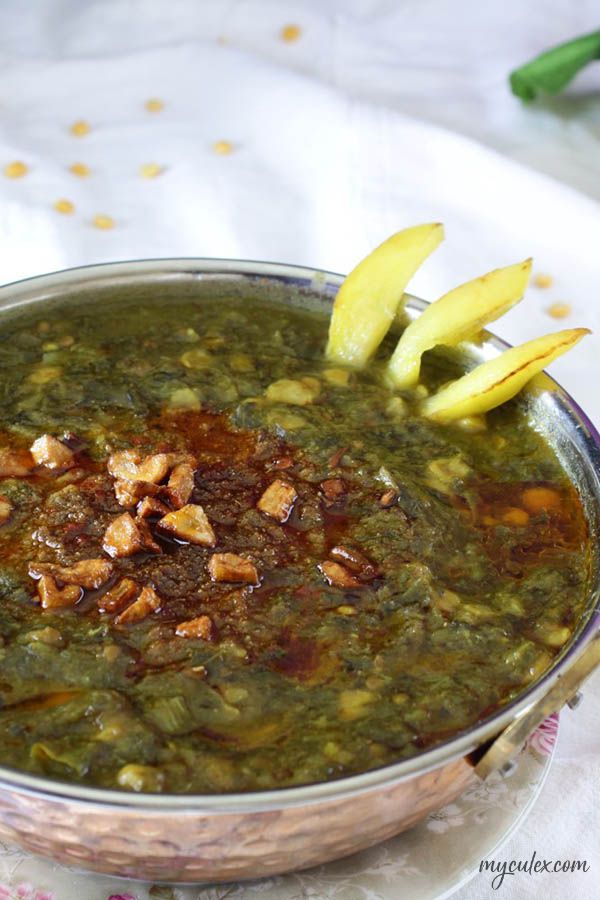

Easy Sai Bhaji Recipe can also be cooked with leaves such as spinach, coriander, and fenugreek leaves with Chana dal instead of sorrel, dill, and other vegetables. Moreover, nowadays with the fuss that children make, this easy version of Sai Bhaji suits everyone’s liking. Have this with Sindhi Tairi , Koki, Roti or Rice.
This healthy Spinach Lentil Vegetable is packed with nutrients such as Vitamin A, Vitamin C, Vitamin K, potassium, iron, fibre from the leafy vegetables, and proteins from the Chana dal lentil.
Dal Pakwan is another popular Sindhi breakfast made with Chana Dal and Moong dal. The nectarous gulab jamuns are always welcome as a dessert.
‘Sai’ in Sindhi means green and ‘bhaji’ means vegetables
Video – How to Make Sindhi Style Dal Palak


Watch this video on YouTube
If you have enjoyed the video, do Subscribe to My Culinary Expressions YouTube channel for more interesting food videos.
Ingredients to make Sindhi Sai Bhaji
- Leafy vegetables – The mainstay is spinach, with tanginess provided by sorrel leaves (Chukka) and dill leaves (Sua). If chukka or dill leaves aren’t available, add a few more tomatoes instead. Avoid big, tough spinach leaves. The addition of a few coriander and fenugreek (methi) leaves enhances the aroma and flavour of Sai Bhaji. It is crucial to thoroughly wash the leafy vegetables When fenugreek leaves are not in season, use a little kasoori methi or just omit.
- Lentil / Dal– Generally Chana Dal is used in Sai Bhaji. However, some people may prefer split green moong dal. I have also heard people use toovar (arhar) dal when their stocks run out. You see such is the adoration for Sai Bhaji.
- Onion – A little onion is added for its unique flavour. Those who don’t eat can omit it.
- Raw Mango: A wee bit of raw mango ‘kairi’ adds to the tanginess.
- Tomatoes – Imparting tanginess.
- Ginger- Added for flavour and digestion. Green chilies- According to your preference.
- Garlic – Essential for the tempering. Those who don’t eat garlic, temper with cumin (Jeera)
- Spices – Salt, coriander powder, red chilli powder, turmeric powder
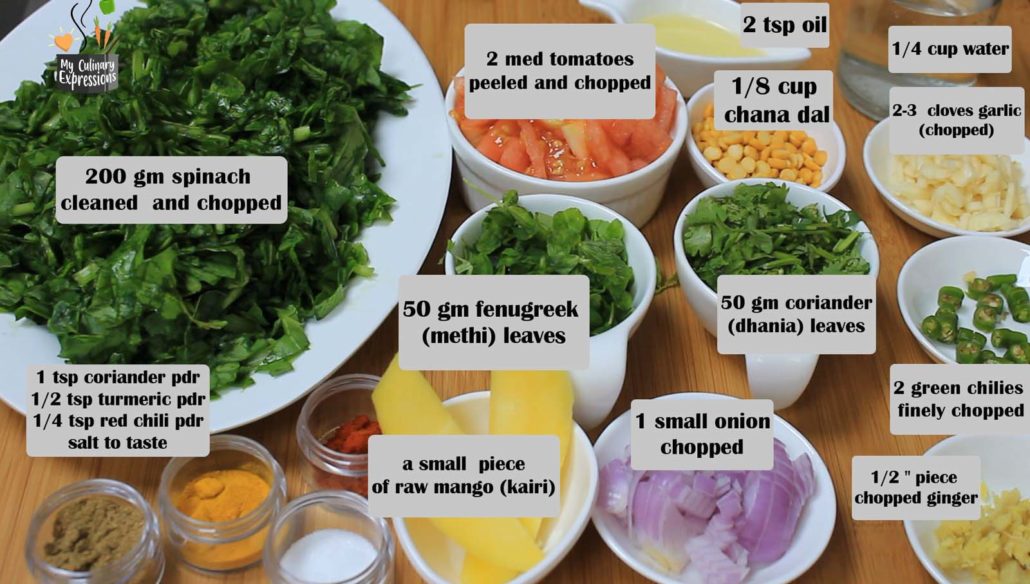

How to make Sai Bhaji in Pressure Cooker
with step by step photos
Cleaning, Chopping and Soaking
Firstly, pluck and sort the green leaves. Then wash and chop them.
Similarly peel and chop tomatoes and onions.
Likewise wash and chop chilies, garlic and ginger.
Soak the Chana dal for around twenty minutes.
First Pressure Cook
Now in a pressure cooker, add chopped spinach, tomatoes, fresh coriander, fenugreek leaves, onion, ginger, and green chilies.
Now add turmeric powder, salt, and water.
Pressure cook for 3 whistles over medium flame.
When steam escapes, open the cooker.
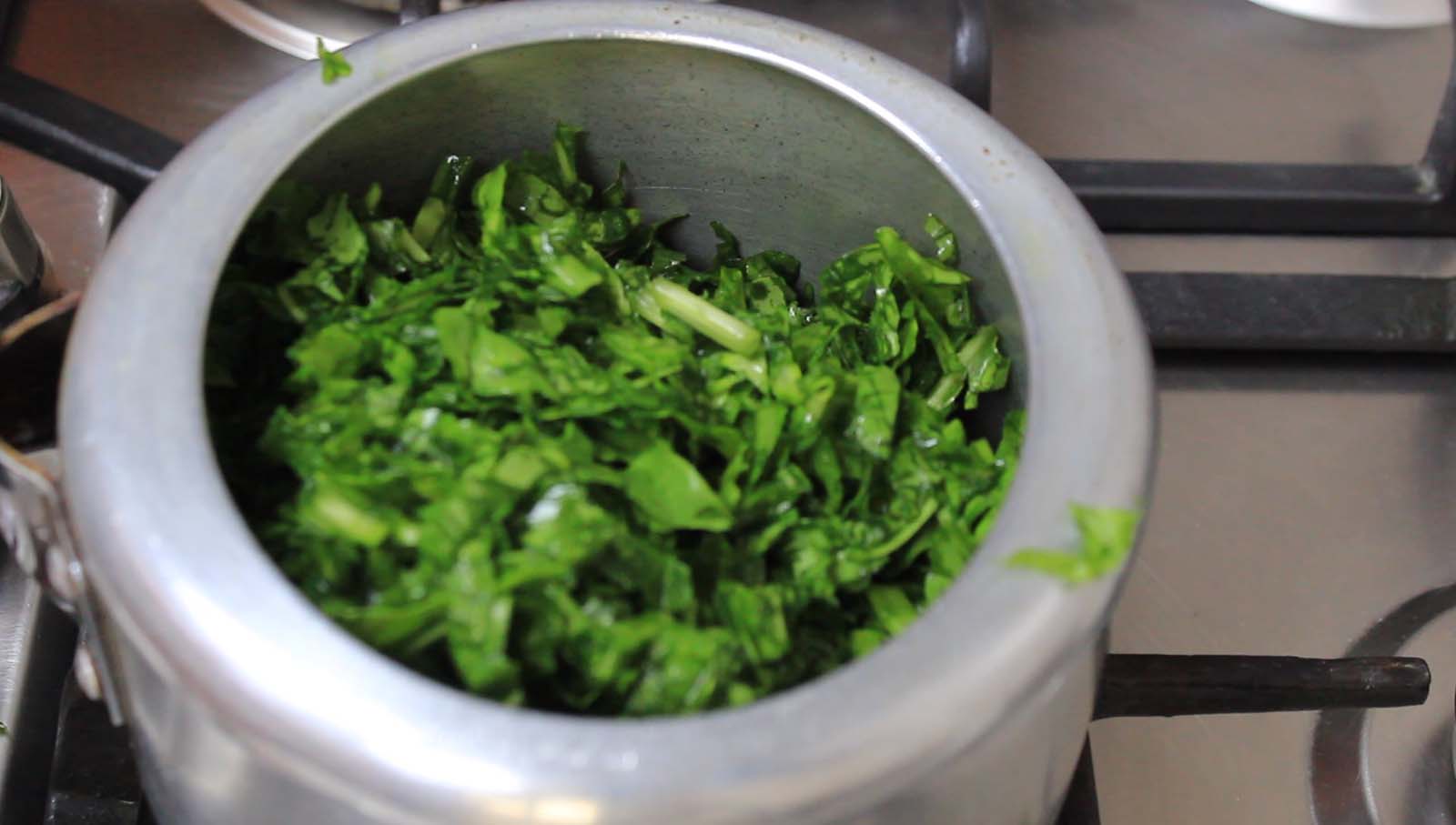

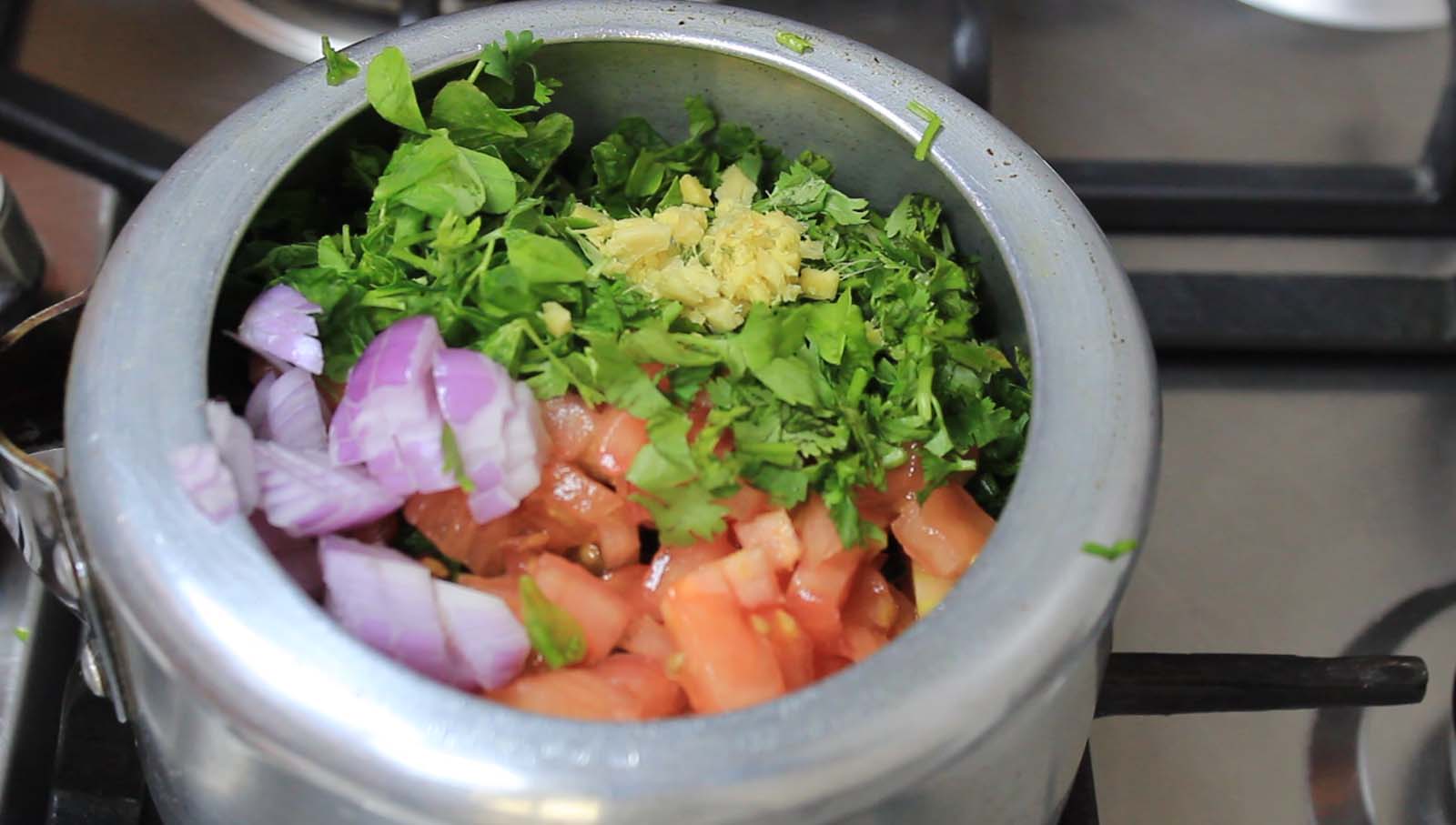

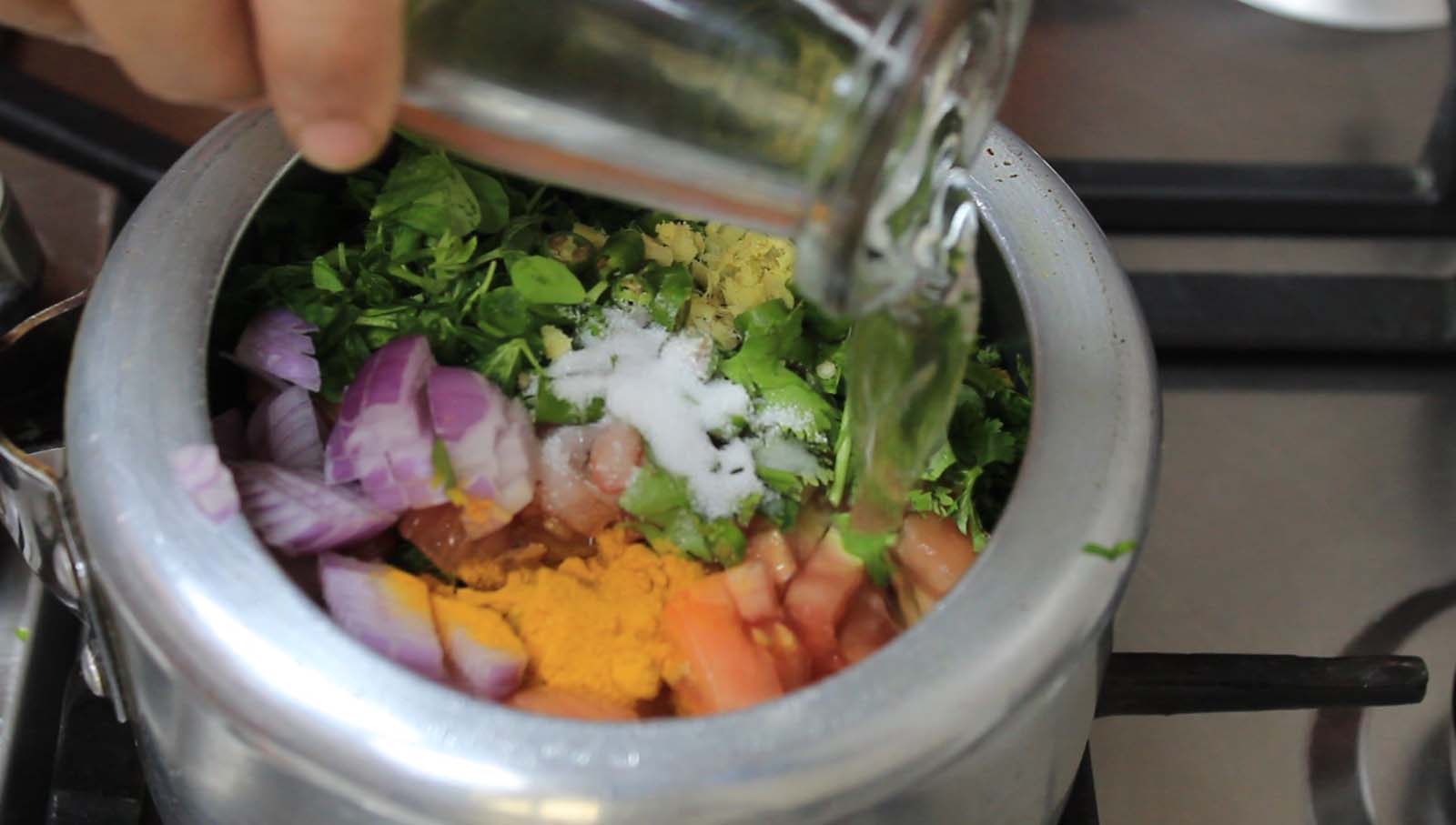

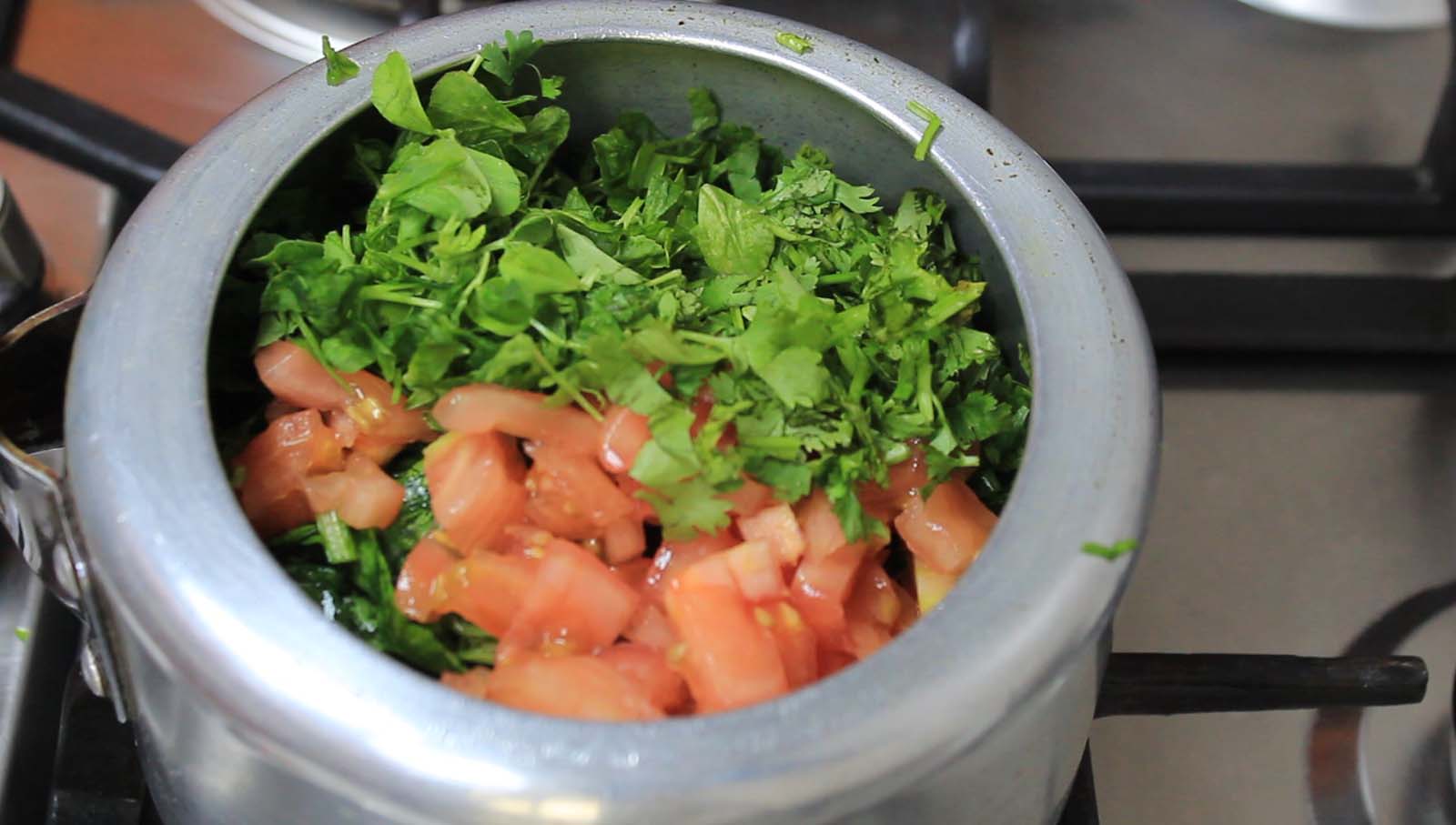

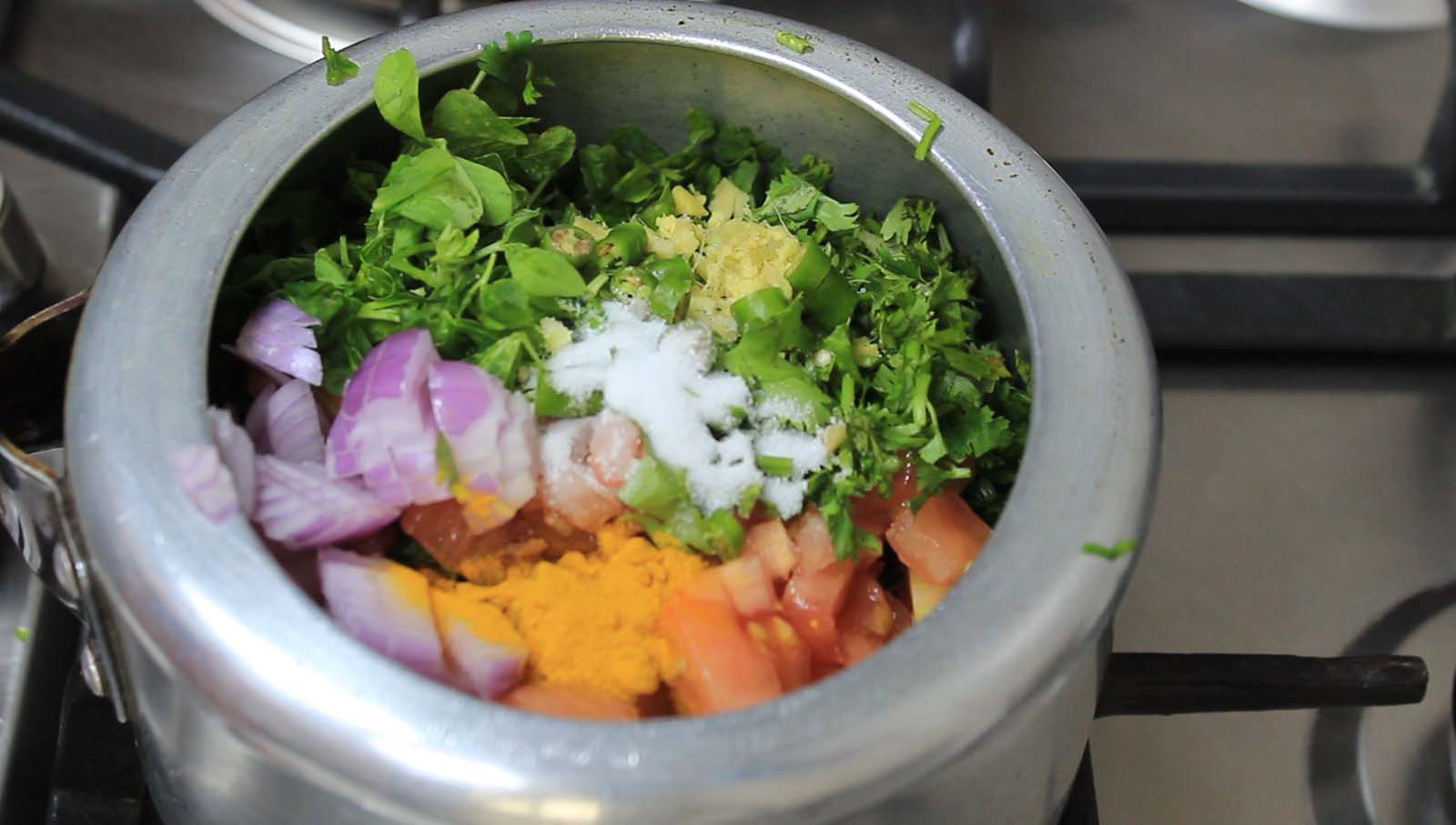

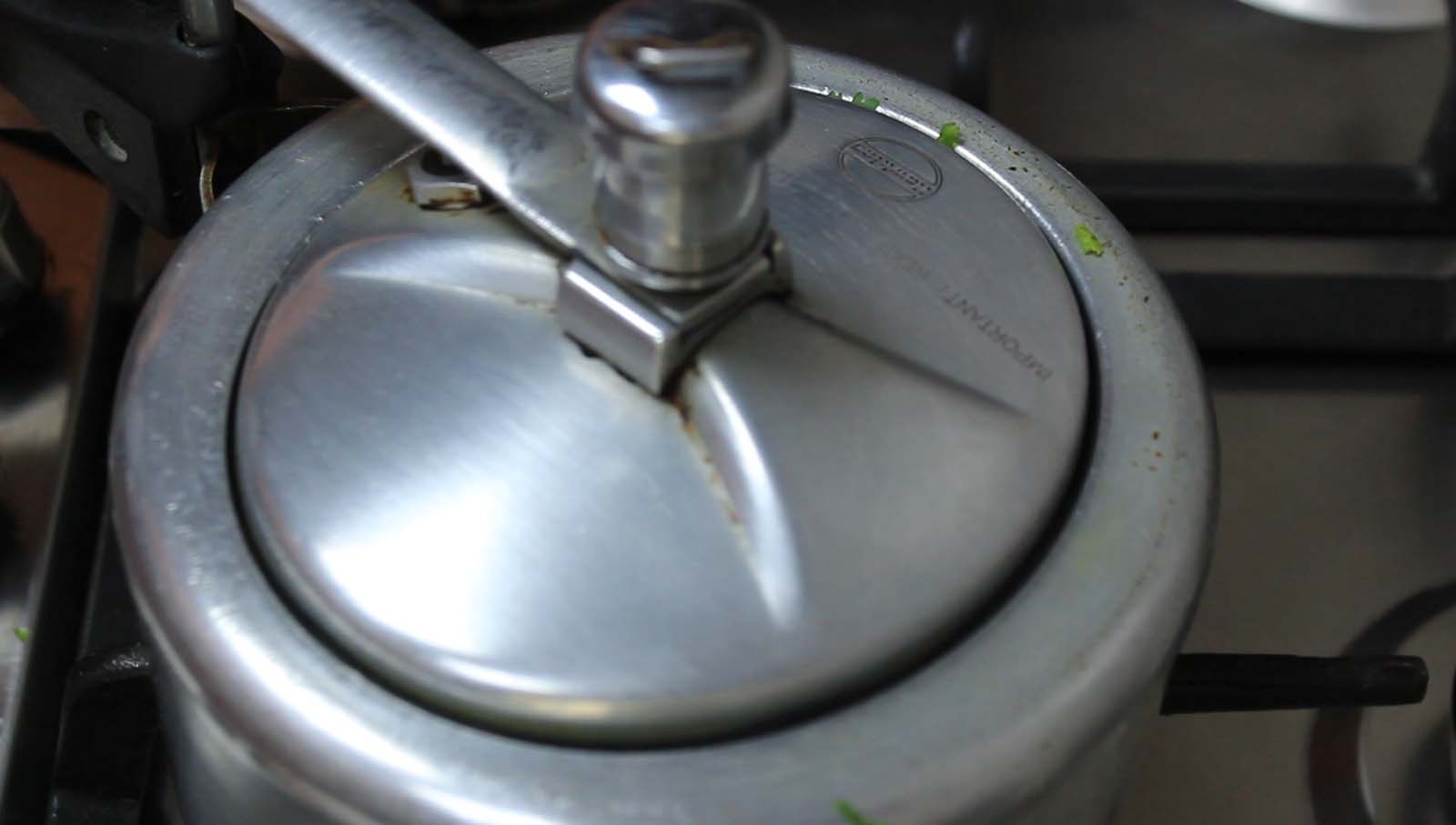

Second Pressure Cook
Slightly mash the spinach..
Add the Chana dal and raw mango.
Pour a little more water if needed.
Pressure cook for 15 minutes on low flame. Some people add the Chana dal along with the other ingredients. I prefer this method because it gives a smooth Sai Bhaji with the Chana dal retaining its shape.
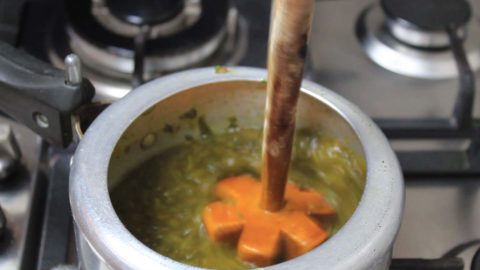

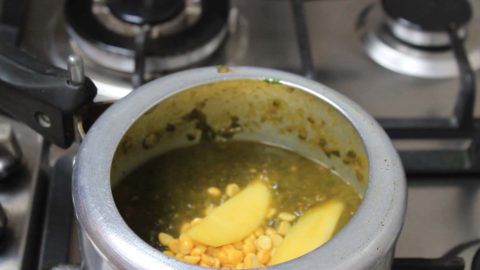

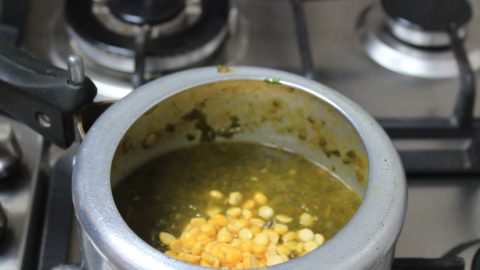

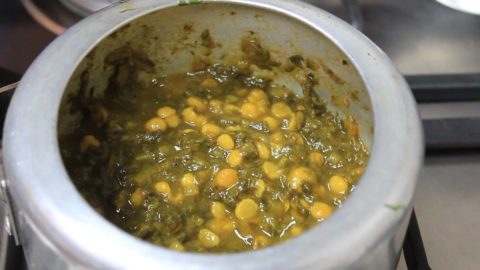

Tempering
Finally for the tempering, sprinkle coriander powder and chilli powder over the Sai Bhaji..
Heat oil in a pan and sauté garlic till light brown and aromatic.
Pour this tempering over the Sai Bhaji and mix gently.
Cover at once and keep aside for 15 minutes for the flavours to blend.
Serve with Sindhi Tairi , Koki, Roti or Rice
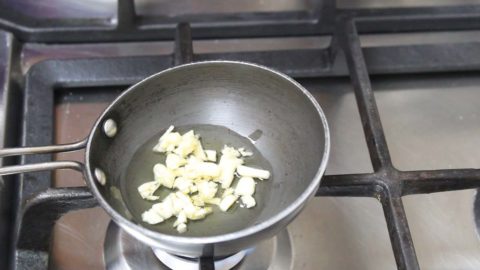

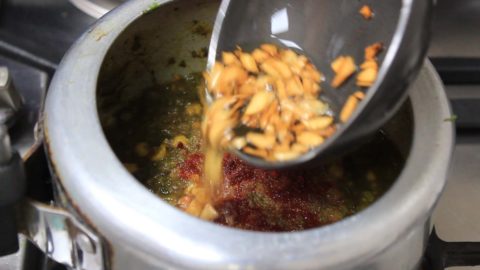

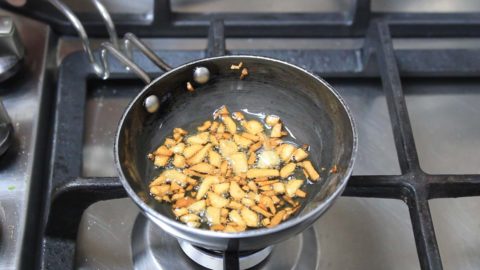

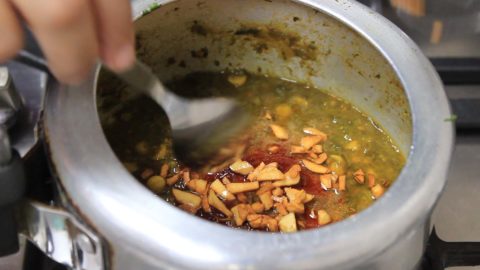

You might also like to try out some other recipes:
How To Make Perfect Sai Bhaji
Clean, wash and finely chop leafy and other vegetables .
The criterion for a perfect Sai Bhaji is a smooth Bhaji with the Chana dal retaining its shape. It shouldn’t be either too thick or runny.
Chana dal is highly recommended but you may swap it with green or yellow split moong dal..
During tempering the garlic should just be sautéed till brown but not burnt.
You can omit onions and swap garlic with cumin seeds.
Recipe Card
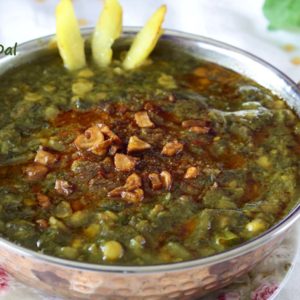

Sindhi Sai Bhaji | Spinach Lentil Vegetable
Ingredients
- 200 gm spinach cleaned , washed and chopped
- 50 gm coriander leaves cleaned, washed and chopped
- 50 gm methi leaves cleaned washed and chopped
- 1/8 cup chana dal
- 1 small onion chopped
- 1 raw mango small
- 2 medium tomatoes peeled and chopped
- 2 green chilies chopped
- ½" piece ginger chopped
- ½ tsp turmeric powder
- ¼ tsp red chili powder
- 1 tsp coriander powder
- Salt to taste
- 2-3 cloves garlic chopped
- 2 tsp oil
- ¼ cup water
Instructions
Cleaning, Chopping and Soaking
- Firstly, pluck sort the clean leaves. Then wash and chop them
- Similarly peel and chop tomatoes and onions.
- Likewise wash and chop chilies, garlic and ginger.
- Soak the Chana dal for around twenty minutes.
First Pressure Cook
- Now in a pressure cooker, add chopped spinach, tomatoes, fresh coriander, fenugreek leaves, onion, ginger, and green chilies.
- Now add turmeric powder, salt, and water.
- Pressure cook for 3 whistles over medium flame.
- Once pressure is released open the cooker
Second Pressure Cook
- Slightly mash the spinach..
- Add the Chana dal and raw mango.
- Pour a little more water if needed.
- Pressure cook for 15 minutes on low flame.
Tempering
- Finally, sprinkle coriander powder and chili powder over the Sai Bhaji.
- Heat oil in a pan and sauté garlic till light brown and aromatic.
- Immediately pour this hot oil over the Sai Bhaji and mix gently.
- Cover at once and keep aside for 15 minutes for the flavours to blend.
- Serve with roti or pulao.
Notes
- All the leafy and other vegetables used should be cleaned and chopped finely.
- The criterion for a perfect Sai Bhaji is a smooth bhaji with the Chana dal retaining its shape. It shouldn’t be either too thick or runny
- Chana dal is highly recommended but you may swap it with green or yellow split moong dal.
- During tempering the garlic should just be sautéed till brown but not burnt.
- You can omit onions and swap garlic with cumin seeds.
You can follow me on Facebook, Pinterest, or Instagram
Thank you for stopping by my blog. Your feedback and comment is much appreciated. Hope you have enjoyed reading this post. Do not forget to Like and Subscribe.
Will be back with another interesting post.
Until then
Stay Bright!
Pin for future reference
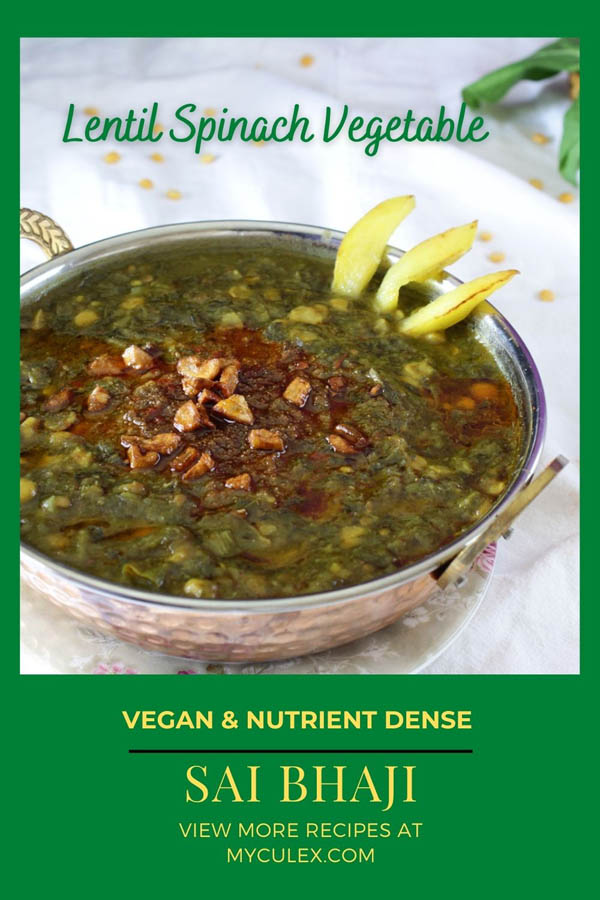




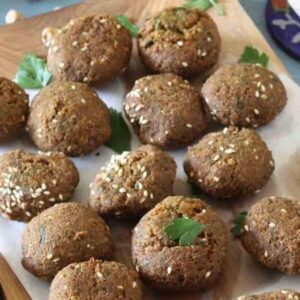
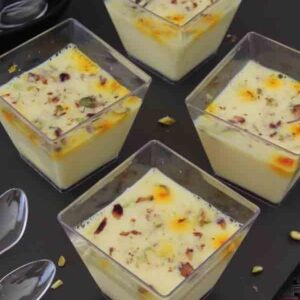
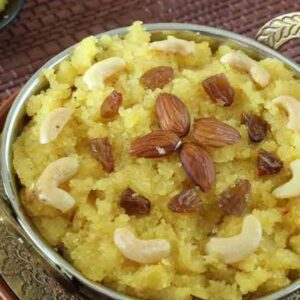
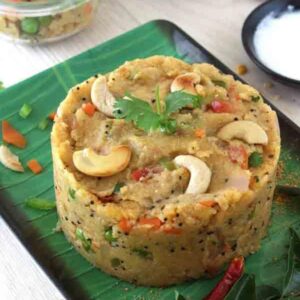
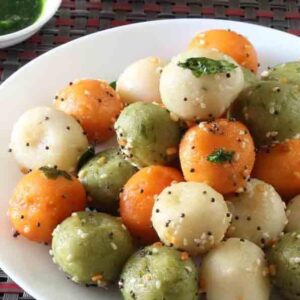
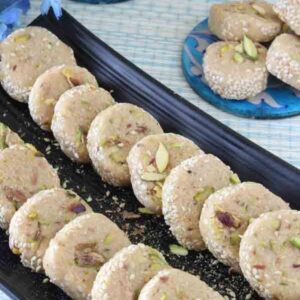

Sai bhaji looks so delicious. This is one of the most nutritious sabzi one can ever make. We can enjoy it with anything.. fulkas, khichnee, pulao, tehri, dhodo.
Thanks. It goes well with just anything. Tairi and Sai bhaji are a great combo.
this is such a delicious baaji. I loved it with soft phulkas and pickled onions. We loved the meal.
Thanks. Your combo choice is a great one. This Sai Bhaji really goes well.
Its been ages since I’ve made Sindhi Sai Bhaji. Love the flavours and the best part is the garlic tempering on top. Both hubby and I love sabji with spinach. I have a whole box of spinach in the fridge and your recipe has reminded me of this delicious dish. Making it this week.
Rightly mentioned, garlic tempering is the epitome of this recipe. Garlic must be tempered just enough. This gives the aroma to the Sai Bhaji.Glad you plan to make Sai bhaji with the box of spinach that you have at hand.
It has been ages since I made Sai Bhaji. I love the idea of using the cooker to make the bhaji. Totally agree with you using the pressure cooker saves time, fuel and nutrients too. I love the variations of using arhar dal or moong dal. Think I will make some with them.
Pressure cooker makes life easier and more so this Sai bhaji just needs boiling and tempering.Please do try it. Im sure you will like it.
am eyeing the sai bhaji along with the garlic garnish on top ! perfect way to feed greens / veggies to kids. yum!!
Garlic Tempering is the deciding factor of this dish. Need to be very careful that garlic doesn’t burn lest the bhaji will turn bitter. Kids generally love it with rice.
I am yet to try this Sai Bhaji, it sounds so flavoursome. I will prepare it sometime soon.
Thanks. Do try it. This is a nutrient dense Sai Bhaji.
I have eaten sai bhhaji so many times but somehow have never made it at home myswlf ,now with an authentic recipe from an expert like you ,it’s surely going to be done soon ! I like the quick pressure cooker method 🙂
This is a very easy version with no compromise on taste. It doesn’t need much time tool
[…] that if you have been to any such occasion you would have got a glimpse of this caramelized Pulao, Sindhi Sai Bhaji, Tairi or Sindhi […]
[…] Sai Bhaji […]